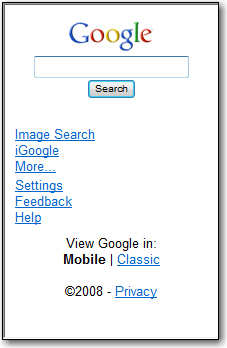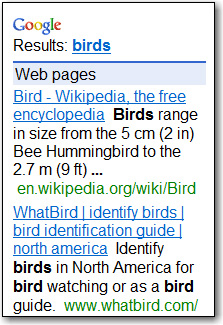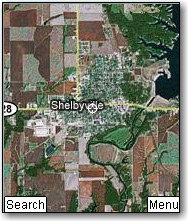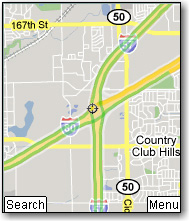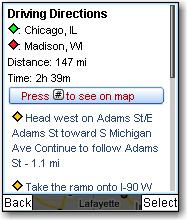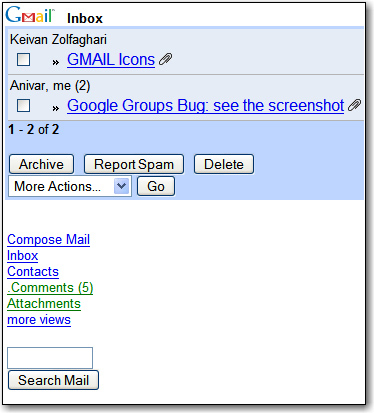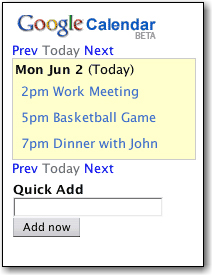To use most Google Mobile services, you must have a Java-enabled (J2ME) phone or mobile device and be subscribed to your cellular provider’s data plan. The service itself from Google is free, although you may have to pay your cellular service provider for airtime or data download fees (which may be a good reason to look into your carrier’s flat-rate data plans...).
Note
Google offers several mobile applications specifically for the Apple iPhone. Learn more in Chapter 36, “Using Google on the iPhone and iPod Touch.”
To learn more about and sign up for Google Mobile, point the web browser on your desktop PC to www.google.com/mobile/. From there, enter the number of your mobile phone, and Google sends an invitation text message to your phone. Click the link in the text message, and you’ll see the Google Mobile home page on your cell phone’s display. As you can see in Figure 35.1, this is the place to start using all the Google Mobile features.
The Google Mobile home page on your mobile phone includes a web search box and the following menu items:
-
Image Search
-
iGoogle
-
More
Note
Alternatively, you can point the web browser in your mobile phone to www.google.com/m; this also takes you to the Google Mobile start page.
-
Feedback
-
Help
Select a menu item to start that service.
Let’s start with the service that Google is known for—searching the web. Thanks to Google Mobile, searching Google on your phone is every bit as easy as it is searching on your desktop PC.
To search Google on a web-enabled phone, all you have to do is go to the Google Mobile home page, enter your query into the search box, and then click the onscreen Search button. Google now returns a list of matching web pages, like the one shown in Figure 35.2. Click any link to view that page on your phone’s web browser.
Beyond basic search, the most useful Google Mobile service for many users is Google Maps. It’s great to be able to access street maps, satellite maps, driving directions, and real-time traffic information from the convenience of your mobile phone—especially when you’re driving in your car!
To access Google Maps for the first time, go to the Google Mobile home page on your cell phone, select More, and then select Maps. This accesses and downloads the Google Maps application. Once downloaded, you can access Google Maps from the web application menu on your phone.
Using Google Maps on your mobile phone is a snap. The first screen you see is a map of North America. To access all the Google Maps features, press the Menu button on your phone’s keypad. This displays an onscreen menu; you can select an option from the menu, or press the keypad button corresponding to that option.
To load a map of a specific location, display the Google Maps menu and select Find Location. You’re now prompted to enter an address, or to select a recent or favorite address. You can use your phone’s keypad to enter a specific street address, a city, a state, or a ZIP code; when you press OK, Google displays a map of the selected location, like the one shown in Figure 35.3.
Once the map is displayed, you scroll the map up or sideways by using the direction buttons on your phone’s keypad. To zoom closer, press the OK or center select button on your keypad; to zoom out, press the Zoom - softkey.
Alternatively, you can opt to display a satellite image of the selected area. Just press the menu key and select Satellite View; the map now switches from a street map to a satellite map, as shown in Figure 35.4.
One of my favorite Google Maps features is the ability to check for traffic congestion; this is especially useful during rush hour. Google displays this information for more than 30 major metropolitan areas.
To display real-time traffic info, select a location, display the menu, and then select Show Traffic. As you can see in Figure 35.5, clear traffic is displayed as a green route; moderately busy streets are displayed in yellow; congested routes are displayed in red.
Google Maps also lets you generate driving directions to or from your current location. This is a real boon when you’re traveling and can’t find a specific location—or just need help getting from point A to point B.
You start by displaying the Google Maps menu; then select Directions. You are now prompted to select a start point and an end point; these can either be points on the current map, or you can enter new addresses.
Google now calculates the route and displays step-by-step driving directions, as shown in Figure 35.6. To view a map of the currently selected step, press the # key on your phone; press the # key again to return to the text directions.
You can also use Google Maps to find local business in your current area. Just generate a map for the area and then click the Search soft key on your phone. When prompted, enter the type or name of the business you’re looking for. Google will now display a list of matching businesses; select any individual business to view more information, or press the # key to view that business on a map. It’s a great way to find the nearest gas station or restaurant while you’re on a road trip!
Tip
You don’t have to use Google Maps to find local businesses. Google offers a local search service that can be accessed from Google’s search function. Go to the Google Mobile home page on your phone and conduct a search for a particular type of business. When the search results screen appears, scroll to the bottom of the screen and enter your location (city, state, or ZIP code) into the Search Nearby box. Google will now return a list of businesses in the selected area.
If you want to keep in touch with the outside world while you’re on the go, you can browse Google News on your mobile phone. Just select News from the Google Mobile More menu, and you’ll see a screen like the one in Figure 35.7. There’s a search box at the top, with a list of today’s top headlines below. Click any headline to read the full story.
Scroll down the screen and, beneath the list of top stories, you’ll see a list of major news categories—U.S., World, Entertainment, Sports, Sci/Tech, Business, and Health. Click any category to view the latest headlines within that category.
You can also search for specific news stories from this same page. Enter one or more keywords into the search box; then click the onscreen Search News button. Google will display a list of matching stories for you to read.
Sometimes even an hour away from your computer can be a bad thing, particularly if you’re expecting to receive an important email message. Fortunately, Google Mobile lets you access your Gmail account while you’re on the go, using your mobile phone.
Of course, to use this feature, you first must have a Google Gmail account. Assuming you have a Gmail account, it’s a snap to access your Gmail inbox from your mobile phone. Just go to the Google Mobile home page on your phone, select More, and then select Gmail. You’ll now be prompted to download and install the separate Gmail application; do so. Once downloaded, you can access Gmail from the web application menu on your phone.
The first time you use the Gmail application, you’ll be prompted for your Gmail username and password. Your phone now displays your Gmail inbox, as shown in Figure 35.8, with all read and unread messages listed.
Click a message header to read the full message. If a message has an attachment, click the attachment to view it onscreen. To reply to this message, press the Menu button and then select Reply. To delete this message, press the Menu button and then select More Actions, Delete.
To create a new message, go to the inbox and then select Compose Mail. Enter the recipient’s email address in the To box, the message subject in the Subj: box, and the text of your message in the main text box. To send the email, press the Actions button and select Send.
Want to keep track of your schedule and appointments while you’re on the go? It’s easy to do, now that Google Calendar is available for your mobile phone.
Note
You can also access your Google Calendar by going directly to calendar.google.com from your mobile phone.
Assuming that you’ve already created a Google Calendar on the Web, it’s simple to access that calendar from your mobile phone. Just go to the Google Mobile home page, select More, and then select Calendar. All upcoming events are displayed on your phone’s screen, as shown in Figure 35.9. Select an event to view more details.
You can even add new appointments from your mobile phone. Just enter the name of the event into Quick Add box; then click the Add Now button. Any events you add from your phone are automatically synched to your web-based calendar.
If you’re a blogger and you use Blogger to host your blog, Google Mobile lets you blog from anywhere at any time, using your mobile phone. All you have to do is create a blog post with your phone, as either a text message or email message. Send the message to [email protected], and your message is automatically posted to your Blogger blog.
The same thing goes if you want to post a photo to your blog. Assuming that you have a camera phone, use your phone to snap a photo and then email that photo to [email protected]. The photo now appears as a new blog post.
If you like Google Mobile on your cell phone, you can customize your own Google personal home page—and then use this page as your starting page for your phone’s web browser. In effect, your Google Mobile personalized home page uses the same content selected for your iGoogle personalized home page on the Web.
Note
Learn how to create a personalized iGoogle home page in Chapter 3, “Creating a Personalized Home Page with iGoogle.”
On your mobile phone, you access your personalized home page by selecting iGoogle from the main screen. You’ll be prompted to log onto your Google account, and then you’ll see the mobile version of the personal home page you created on the Web.
If you like what you see, you can tell your cell phone to save this page as a favorite, or (when allowed) set this page as your phone’s home page. Know, however, that many cellular service providers don’t let you change home pages; they like you to lock into their home page, whether you like it or not.
We’ve discussed only the most popular features offered by Google Mobile. If you have a web-enabled cell phone, you can also access the following Google Mobile services (from the More menu):
-
Google Docs (view word processing and spreadsheet documents—but not, as yet, presentations).
-
Google Notebook (view and create notes and to-do lists).
-
Google Reader (view blog posts and newsfeeds).
-
Photos (from your Picasa Web Albums).
-
YouTube (view videos).
Learn more about all of these features at mobile.google.com.
Google Mobile requires the use of a web-enabled cell phone. But even if your phone doesn’t have Internet capability, you can still use it for Google searches—using text messages.
Here’s how it works. Just create a new text message with your query as the message text; then send that message to number 46645 (that’s “GOOGL” in numbers). Google will immediately text message back the matching results.
You can use this text-messaging approach to search for all sorts of information on Google—weather conditions, driving directions, sports scores, stock quotes, you name it. All you have to do is include the appropriate keywords in your query, and Google will know what type of search to conduct.
Here’s just a sampling of information you can search for using Google’s text messaging:
-
Weather conditions and forecast—.Enter the keyword weather, followed by the ZIP code or city name.
-
Real-time flight info—.Enter your flight number.
-
Stock quotes—.Enter the ticker symbol for the stock.
-
Sports scores—.Enter the name of the team (available only for sports in season).
-
Driving directions—.Enter the starting location, followed by the keyword to, followed by the ending location, like this: minneapolis mn to hudson wi.
-
Local businesses—.Enter the type of business, followed by the ZIP code, city, or state name.
-
Movie showtimes—.Enter the name of the movie, followed by the ZIP code or city name.
-
Product prices—.Enter the keyword price, followed by the product name or details; comparative prices are returned from the Google Product Search shopping search engine.
-
Word definitions—.Enter the keyword define, followed by the word you want to look up.
-
Foreign-language translations—.Enter the keyword translate, followed by the word to be translated, followed by the keyword in, followed by the language, like this: translate toilet in german.
-
Conversions—.Enter the first number, followed by the keyword in, followed by the second number, like this: 20 dollars in yen.
-
Mathematical calculations—.Enter the appropriate formula, like this: 5*5 or 10/3 or 2+2 or 7-5.
Here’s a Google service that’s not web-based. Google now offers voice-based directory service. GOOG-411, as it’s called, is a voice-activated service that taps the same database used in Google Maps. It’s just like the directory information you normally have to pay for when you dial 411; Google’s service is free.
To access GOOG-411, dial 1-800-GOOG-411 (1-800-466-4411) from your phone and speak your request. You’ll hear a voice menu of matching numbers; speak your selection, or press the corresponding key on your phone keypad. You’ll be automatically connected to the selected business.
If you want a text version of your results, just speak “map it” into the phone. Google will now send you a text message with details of your search, along with a link to a map of the location you asked about. Click the link to view the map on your phone’s screen.
And remember—the service is completely free!

